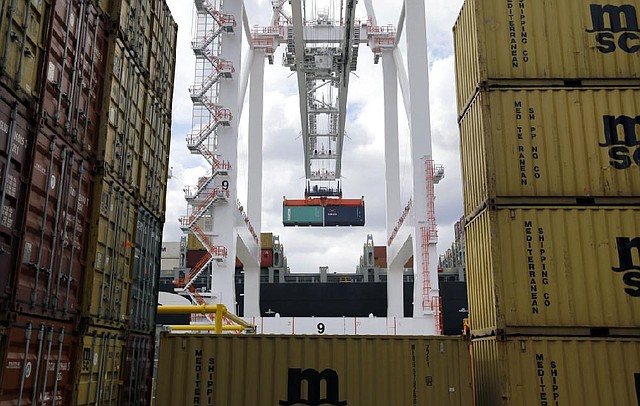Import lull shrinks trade gap 11%
Crude-oil purchases in March at lowest rate since 1996
A crane moves a container from a ship at the Port of Baltimore’s Seagirt Marine Terminal in March. The U.S. trade deficit narrowed in March, the Commerce Department said Thursday.
Friday, May 3, 2013
The U.S. trade deficit narrowed more than forecast in March to its second-lowest level in three years as imports of consumer goods and business equipment declined.
The gap shrank 11 percent to $38.8 billion from a revised $43.6 billion in February, the Commerce Department reported. The median forecast in a Bloomberg survey of 67 economists called for a $42.3 billion deficit. Imports dropped by the most since February 2009 as the U.S. shortfall with China fell to a three-year low.
Increasing exports of American-made goods may prove difficult as companies such as Dow Chemical Co. contend with slower growth in parts of Asia and struggling economies in Europe. At the same time, U.S. demand for imports has waned as businesses stockpile less and households cut back on purchases.
“We’re going to get an upward boost to first-quarter growth from trade,” said Brian Jones, senior U.S. economist at Societe Generale in New York. Still, “imports being down means weaker domestic demand.”
Bloomberg survey estimates ranged from deficits of $38.5 billion to $45 billion. The Commerce Department revised the February shortfall from an initially reported $43 billion.
Imports decreased 2.8 percent, the most since February 2009, to $223.1 billion in March from $229.6 billion the month before. Purchases of foreign made capital equipment and consumer goods dropped.
The import figures included 215.7 million barrels of crude oil compared with 204.8 million the previous month. Accounting for three extra days in March than in February, crude-oil imports averaged about 7 million barrels a day, the lowest since March 1996.
Excluding petroleum, the trade shortfall narrowed to $17.7 billion in March from $22.2 billion.
Exports decreased 0.9 percent to $184.3 billion, reflecting fewer overseas sales of foods, motor vehicles, capital equipment and consumer goods.
Trade subtracted 0.5 percentage point from economic growth in the first quarter, the most since the last three months of 2011, the Commerce Department reported on April 26. GDP rose at a 2.5 percent annualized rate from January through March after a 0.4 percent gain.
The economy is projected to cool to a 1.5 percent pace in the current quarter and then accelerate in the last half of 2013, according to a Bloomberg survey of economists from April 5 to April 9.
Dow Chemical has noted slower economies in Europe and some Asian economies. Chinese demand for chemicals and materials was down 3 percent in the first quarter from a year ago, Dow Chairman and Chief Executive Officer Andrew Liveris said.
“We are seeing decent improvements in the United States as well as in southeast Asia and Brazil,” Liveris said on an April 25 earnings call. “But China has not seen strong market traction coming out of the Lunar New Year, and conditions in Europe remain very weak.”
“Consumption is down.They have pushed down government spending on all wasteful areas, including frivolous things like banquets. So I would tell you China is soft but starting to show trend-positive,” he said. “Importantly, conditions do seem to be stabilizing in the global macro-environment, which is a positive sign.”
For Marathon Petroleum Corp., based in Findlay, Ohio, a slowdown in exports early in the year was attributed in part to muted demand in Europe.
“There were a number of factors that tended to cause a bit of a weakness in the export market,” Mike Palmer, senior vice president of supply, distribution and planning, said on an April 30 earnings call. “Certainly, there was Europe.”
Thursday’s report showed the trade gap with China narrowed to $17.9 billion from $23.4 billion. The deficit with Canada dropped to $2.3 billion from $2.5 billion and with Mexico widened to $5.3 billion in March from $4.3 billion.
Information for this article was contributed by Chris Middleton of Bloomberg News.
Business, Pages 29 on 05/03/2013
